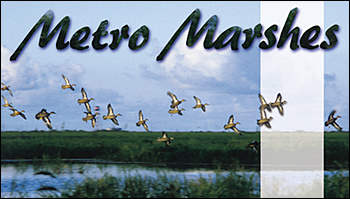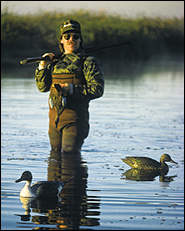
By Chester Moore, Jr.
Page 2
Looking at last year's overall harvest data, 1,316 hunters took a total of 1,522 birds for an average of 1.15 birds per hunter. That total includes 1,291 ducks and 231 geese.

National Wildlife Refuges like the Anahuac NWR provide low-cost, high-quality waterfowl hunting. However, it's nothing like a guided hunt. Pre-hunt scouting is critically important. So is the ability to capitalize on quality terrain, properly set up decoy spreads and effectively use calls for a wide variety of species.
|
The top five duck species taken were: green-winged teal, 396; blue-winged teal, 287; gadwall, 196; northern shoveler (spoonbill), 88; and scaup, 73. There were 194 snow geese taken, 31 white front (specklebellies), 4 Canadas and 2 Ross' geese.
While the harvest has gone down dramatically from 10 years ago when there were 2,363 birds taken, McDowell says it's important to look at the overall picture.
He says the refuge and the areas around it have experienced some fairly dramatic changes over the last few years that may have affected hunting success and which species use certain areas.
"The most immediate and large change that comes to mind is Tropical Storm Frances last September," he says. "For hunters who aren't familiar with Frances what happened last year right before the early teal season is that we got a 6- to 7-foot wall of saltwater all throughout the marsh and it stood there for a while and destroyed vegetation.
"Sometimes a natural catastrophe like that can actually have positives for wetlands," he admits. "One thing it did was help us control some of the nuisance vegetation that doesn't take kindly to saltwater. Another example of what it did is the widgeon grass growing in the East Unit. We didn't have that much in there before and now we have a lot."
Something else that has affected hunting on the refuge are environmental trends surrounding the refuge.
"On the Upper Coast you've got population growth that is impacting surrounding wetlands and agricultural lands. When we lose land in this area we lose waterfowl habitat. Period," McDowell stresses. "Also, over the last couple of years, the rice market has been really bad and that has forced farmers to not plant certain areas or convert it over to something else. Our rice is one of our big drawing cards for geese and ducks."
The bad rice market has even affected areas within the refuge. Some of the land within its boundaries is farmed by private individuals and this year at least one farmer wasn't able to plant for economic reasons. That means less rice to hunt.
The rice situation is also affecting private waterfowl outfitters who are, in some situations, encountering increasing lease fees. One outfitter told me a landowner who lost a lot of money on rice wanted to charge him $3,000 for one blind.
"Despite those factors, right now we're looking at a potentially good season," McDowell reports. "We've got a record fall flight and with any luck we'll have a strong enough winter to push birds down to our end of the coast where we can enjoy a good season. We're in September now and our biggest concern is water. We're very dry and that could affect things. Hopefully we will get adequate rain to provide optimum habitat."
Hunters are charged $10 a day to hunt the refuge which is a bargain in comparison to guided hunts. Of course refuge officials don't provide guide service, retrievers, lodging and other amenities, but for hunters on a tight budget it's a heck of a deal.
Another option is for hunters to purchase an annual $40 hunting permit which allows them to hunt any of the units during designated times throughout the year.
"The permit is really the way to go for hunters who want to hunt here a bunch," McDowell says. "There is some confusion with the permits though. This is a special permit for the Anahuac Refuge only. It doesn't cover other areas and it's not the same $40 permit that Texas Parks & Wildlife officials offer for their public lands. We get a lot of confusion over this and would like to save hunters the trouble of going out and buying a state permit when they're planning on hunting on this refuge and not state areas."
For hunters who have never given Anahuac a shot, this may be the season to do it. Like McDowell says, we have an enormous flight of birds that are supposed to make their way through the area.
And hunters who venture into the Anahuac NWR may just get into the best hunting of their lives. You never known until you try and you sure can't beat the price.
(Note: The Anahuac refuge office is located at 509 Washington Ave. in Anahuac. To get to the refuge itself: From I-10 at the Anahuac/Hankamer exit, go south 2 miles to FM 562. Continue south on FM 562 for 8.3 miles to FM 1985, and 4 miles east to refuge entrance. For more information call 409-267-3337.)
# # # #
page 1 / page 2
| 
